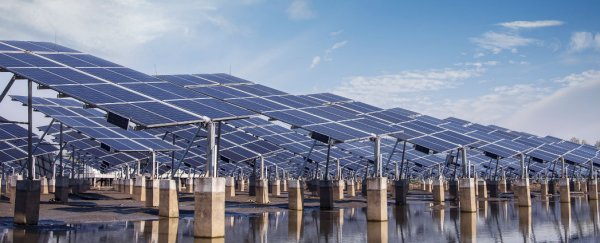In an experiment that could nearly double the rate of solar energy conversion from 32 to 60 percent, scientists in Switzerland have used the super-material graphene to convert a single photon into many electrons to produce an electric current.
The team, from the Swiss École Polytechnique Fédérale de Lausanne (EPFL), demonstrates how graphene could join cadmium telluride, copper indium gallium selenide/sulphide, and various silicon structures as one of the few known photovoltaic materials - high-efficiency, solar energy-producing materials.
They achieved this by placing a sample of graphene - a thin layer of pure carbon that's around 100 times stronger than steel and a very efficient heat and electricity conductor - into an ultra-high vacuum chamber. The graphene they used was 'doped', which means electrons were added or subtracted chemically before the experiment.
The graphene was then blasted with a super-fast pulse of laser light, which 'excites' the electrons floating around in the graphene and puts the whole material into a higher energy state than before the laser blast. In this state, says Michael Byrne at Motherboard, an excited - or 'hot' - electron might "pop loose from its atomic home", and when it very quickly falls back into its regular state of energy, it excites an average of two more electrons as a knock-on effect. This phenomenon can then be conducted as an electric current and used for power, and it all happens in a matter of femtoseconds, so a few quadrillionths of a second.
The team observed this phenomenon for the first time by recording the energy of each electron at different points in time, over and over again, like "a kind of stop-motion movie of the conversion process", says Dexter Johnson at IEEE Spectrum.
"This indicates that a photovoltaic device using doped graphene could show significant efficiency in converting light to electricity," one of the team, materials scientist Marco Grioni, said in a press release.
The amount of energy you need to force an electron free depends on the material you're using. If the amount of energy you need to achieve this phenomenon is too great, the material will be considered inefficient, because the leftovers will end up as wasted heat energy. But this new technique, known as carrier multiplication, uses that leftover energy to 'pop loose' more electrons so they can be harvested for power.
The results have been published in Nano Letters.
It's pretty exciting stuff, because graphene is even better at conducting electricity than copper. But there's one big problem - graphene isn't great at absorbing light, which is pretty crucial if you want to make solar panels and the like out of it.
Michael Byrne explains at Motherboard:
"Being able to convert sunlight to electricity at very high efficiencies doesn't much matter if the material wants to ignore the light in the first place. And there is also the question of how exactly to harvest current from graphene, the edges of which tend to have different conductivity properties than the central zones and are also quite reactive when exposed."
But Grioni's team would be all too aware of this fact, so I'm hoping they have some kind of solution up their sleeves. It would be truly amazing if they could double the upper-limit of solar energy conversion using a material as cheap to produce and great at conducting as graphene.
Sources: Motherboard, IEEE Spectrum
